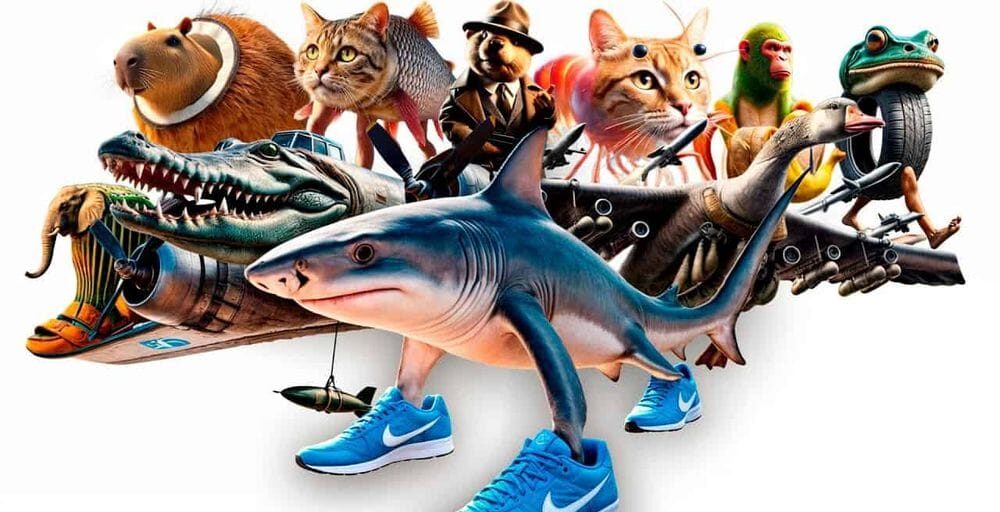- HOBBIES
The Very Best 45 Green Eyes Facts


In the wild world of internet slang, few words capture the bizarre nature of digital obsession quite like “brainrot.” Originally used to describe the mental deterioration caused by excessive exposure to niche or ridiculous content, the term has evolved into a badge of honor for chaotic, meme-worthy phenomena that consume our attention. In Italy, this concept has found fertile ground in the creation of the “Italian Brainrot List”—a tongue-in-cheek compilation of uniquely Italian trends, viral moments, and cultural oddities that are so ridiculous, so specific, and so iconic, they’ve become a form of national comedy.
“Brainrot” in internet culture refers to the kind of content that is so aggressively weird, exaggerated, or overplayed that it gets stuck in your head—usually in the form of memes, quotes, or repetitive clips. It’s the stuff that shouldn’t live rent-free in your brain, but somehow does. Think of it as a type of absurdity overload where logic gives way to laughter.
In the Italian context, brainrot takes on a special flavor. With a society steeped in melodrama, expressive language, regional quirks, and a rich media landscape, Italy is the perfect breeding ground for brainrot content. From over-the-top reality shows and Eurovision entries to TikTok-fueled slang and ironic nostalgia, Italian brainrot thrives at the intersection of humor, chaos, and cultural self-awareness.
Several cultural currents feed the creation and virality of the Italian Brainrot List:
Here are some gloriously weird examples that have secured their place in the pantheon of Italian brainrot:
A random supermarket ad for grated cheese somehow went viral due to its overly dramatic voiceover and cinematic presentation. People began parodying it as if it were a trailer for an Oscar-winning film about dairy.
The Italian music festival Sanremo is a goldmine for brainrot. Mahmood’s heartfelt, hyper-expressive live performances—complete with dramatic lighting and painful eye contact—spawned a thousand TikToks, parodies, and edits.
The pinched fingers emoji (🤌) is more than just a gesture; it’s the symbol of Italian essence. It has been memed into oblivion, often used ironically to comment on things that are both “too Italian” and hilariously stereotypical.
A TikTok trend involving a man tearfully saying “Ciao, gatto” to a random cat while somber music plays. The emotional intensity paired with complete absurdity made it a perfect brainrot moment—equal parts cringe and endearing.
An old voicemail left by politician Matteo Renzi was leaked and turned into a viral auto-tuned remix. The juxtaposition of dry politics with beat drops and club visuals turned it into Italy’s unintentional summer hit.
Host of Grande Fratello VIP, Alfonso Signorini’s dramatic runway-style walks during live shows have become meme gold. No context needed—just looping video clips of him striding toward the camera with unsettling confidence.
Long-time TV host Barbara d’Urso became a meme queen thanks to her overly dramatic reactions, camera zooms, and soap-opera-worthy pauses. Her show intros, where she reads scandalous news with slow blinking and intense stares, are clipped endlessly on TikTok with absurd captions like: “When your pasta falls on the floor.”
This old Roman song turned viral audio is used to dismiss literally anything from political scandals to failing exams. Often paired with videos of chaos or disaster, the tune represents Italy’s darkly comedic way of saying: “Eh, life goes on.”
The pop-opera trio Il Volo, always overdressed and painfully sincere, have become the poster children for “Italian overcommitment to drama.” Their polished performances often get memed with captions like: “When you think you’re auditioning for La Scala but you’re just at karaoke night.”
The endless debate resurfaces every few months on Italian social media. What starts as a joke (“Pineapple on pizza is fine!”) escalates into national pride warfare. Memes flood in, comparing it to war crimes and threatening to “report you to Nonna.”
Low-budget Italian Christmas comedies (cinepanettoni) like those starring Christian De Sica or Massimo Boldi are remixed with dark synthwave music or philosophical subtitles. A goofy slapstick scene becomes a “metaphor for late-stage capitalism.”
Late-night TV is still riddled with ads for mystical fortune tellers with sketchy phone numbers. These psychic hotline commercials, featuring dramatic close-ups and haunted violins, are clipped and parodied by Gen Z as peak boomer brainrot energy.
This viral line comes from a real video of a runaway horse on the beach with a man screaming “TADDEO, RIPRENDILO!” (“Taddeo, get him!”). Italians use the phrase now anytime something spirals out of control—like your roommate burning garlic bread or your Vespa tipping over.
Footage of someone trying (and failing) to park a Fiat 500 in a tiny Roman alley became the poster clip for Italy’s parking chaos. Meme captions often go: “She’s giving Roman Renaissance chaos energy.”
This phrase (“Let me tell you in Neapolitan…”) is used before saying literally anything, from ordering food to threatening vengeance. TikToks and reels dramatize it with cinematic flair, turning dialect into performance art.
Certain Milan Fashion Week moments—like someone walking a literal bread loaf purse or wearing a full mozzarella dress—are clipped and memed to represent the absurd lengths of Italian fashion. Commentary often includes lines like: “This outfit walked so pasta couture could run.”
Older Italians on Facebook post conspiracy-laced memes or chain messages with chaotic grammar and bold comic sans text. Zoomers screenshot them and reframe them as ironic masterpieces with captions like: “Postmodern dadaism.”
Whether it’s kissing other performers mid-performance or showing up with latex bondage gear, Rosa Chemical is the agent of brainrot Italy didn’t know it needed. Eurovision fans now use him as a mascot for peak cultural absurdity.
Someone recreated Silvio Berlusconi in The Sims and gave him bizarre daily tasks like flirting with ghosts or starting fires during barbecues. The simulation somehow felt more believable than reality.
Italian commercials for things like toilet paper or dish soap often play like short melodramas with orchestral music, family reunions, and slow-motion hugs. The brainrot lies in the emotional overkill for mundane products.
This culinary war crime (putting Parmigiano in carbonara instead of Pecorino Romano) became an online scandal. People acted like it was treason against the republic, with reaction videos, duets, and over-the-top threats like: “You’ll be tried in the pasta court of Rome.”
Host of the Italian version of Art Attack, Giovanni Muciaccia, is now forever linked with DIY chaos and cursed nostalgia. People make edits of him dramatically saying “Colla vinilica!” as if summoning dark forces. Bonus brainrot: fear of Neil Buchanan’s disembodied hands.
Italy’s obsession with synchronized line dances (especially at weddings, beaches, or village festivals) has led to infinite memes. Songs like “Il Pulcino Pio” or “La Cucaracha” are viewed as brain-melting earworms from which there is no escape. TikToks now edit them like horror movie trailers.
Mina, Italy’s legendary diva, is often remixed into Gen Z edits with vaporwave music and glitch aesthetics. Her nickname “La Tigre di Cremona” is exaggerated into anime intros or boss-level video game battles. Think: “Final Boss of Italian Pop.”
The beloved crooner’s emotional, nasal delivery—especially when he belts “PIÙ BELLA COSA”—has been lovingly memed as sounding like he’s fighting for his life in a karaoke booth. It’s a national sport to imitate him dramatically in the car.
TikToks parody grandmothers giving “benedizioni” (blessings) that are equal parts comforting and lowkey threatening. Example: “Che Dio ti benedica… ma se non mangi questa pasta, ti rincorro col mestolo.” A perfect example of emotional whiplash, Italian-style.
Videos of pigeons aggressively following tourists, stealing cornetti, or simply loitering like mafia bosses have turned these feathered fiends into symbols of Italian urban life. Memes often add Sopranos music or mafia dialogue like: “We don’t talk to the sparrows.”
Italians on TikTok have turned the “scooter sound” (that unmistakable high-pitched Vespa buzz) into the country’s unofficial theme song. It’s often overlaid onto historical footage, like Roman chariot races or Mussolini speeches, for maximum absurdity.
Every Sanremo Festival births multiple brainrot entries: awkward dance moves, misfiring pyrotechnics, unhinged audience reactions, or Achille Lauro showing up covered in gold paint riding a mechanical bull. Nothing makes sense. That’s the point.
This phrase—yelled by hosts on trash TV after the most mildly average performance ever—has become a sarcastic staple. You’ll see it on TikTok anytime someone does the bare minimum, like opening a door or showing up to work.
Some Italian towns dress up Virgin Mary statues or saints in local sports team scarves or zip-up jackets. When pictures of these outfits hit the internet, it sparks debates like: “Is this blasphemy or high fashion?” Either way, it’s certified brainrot.
Before texts, Italians used to send a missed call (“uno squillo”) as a coded message: “I’m outside,” “Call me,” “I like you.” Today, Gen Z is bringing this back ironically—with videos showing dramatic reactions to missed calls set to opera music.
You’ll see a journalist asking a simple question like “Do you like pizza?” and suddenly the person dives into a five-minute speech about politics, the economy, or their failed marriage. These clips are edited into trailers for fake Netflix documentaries titled “Spaghetti e Morte.”
The fact that some Italian police officers still drive tiny Fiat Pandas is too funny to ignore. TikTok users add dramatic chase music (like from Fast & Furious) over clips of these tiny cars moving 30 km/h. Italy’s version of high-speed pursuit.
This saying (“Christmas with your family, Easter with whomever you want”) gets brutally tested every year as Italians post TikToks about the stress, judgment, and culinary warfare that comes with holiday meals. It’s never just about the lasagna.
The Italian Brainrot List is more than just a meme dump. It has become a collective scrapbook of the ridiculous—a way for people to catalog their national quirks and shared moments of chaotic brilliance. It acts as a real-time barometer for what resonates with Italians online, often blending high and low culture in the most unexpected ways.
This digital phenomenon has also sparked conversations about how humor is used to cope with cultural contradictions: the tension between tradition and modernity, regionalism and national unity, elegance and trash TV. In a way, brainrot content allows Italians to laugh with themselves rather than at themselves.
The Italian Brainrot List is a chaotic, brilliant, and totally unserious chronicle of the country’s evolving culture. It thrives on irony, satire, and self-awareness—reflecting how Italians navigate a digital world full of contradictions. Whether you’re in Milan or scrolling from abroad, these moments offer a surreal but sincere glimpse into Italy’s collective psyche.
So next time you see a video of someone solemnly whispering “ciao gatto” to a street cat or remixing Sanremo ballads with trap beats, remember—you’re witnessing brainrot at its finest.
Got your own favorite Italian brainrot moment? Join the conversation, share it with your friends, and embrace the glorious nonsense that is contemporary Italian culture. After all, if culture is the soul of a nation, then brainrot is its chaotic inner monologue.